The ability to adjust the drum tilt means you can use it comfortably regardless of your height and constitution. This saves time and energy substantially.
No transportation wheels available.
The wide 50-cm drum opening makes loading materials much easier. This model will make concrete mixing fast and simple for your convenience.
Small size building projects
Gravity mixer
90 litres
~50 cm
60 litres
450 W (28 rpm)
Ring
Barrow height swivel stand
1.02 x 0.81 x 1.23 m
Steel
35 kg
Amazon's 30-day return policy
The volumetric drum can mix up to 120 litres of materials per cycle, speeding up the process of laying cement significantly.
Not the perfect choice for mixing small loads.
The Switzer model is a great solution for construction workers building small- and medium-sized objects. It's noted for its longevity and incredible power.
Small and medium size building projects
Gravity mixer
120 litres
34 cm
90 litres
550 W (28-30 rpm)
Ring
Round handle, wheels for easy transport
1.05 x 0.69 x 1.26 m
Steel
44 kg
1 year
The paddles are placed inside the drum in a unique way that mixes both large volumes and small loads of up to 10 litres excellently.
The casing is painted rather poorly.
Do you plan to make a cement screed with no professional help or construct some little object? The Megamix small cement mixer should be a good pick for you then, as it will save a bunch of your time and energy.
Small size building projects
Gravity mixer
70 litres
24 cm
~45 litres
250 W (30 rpm)
Ring
Handle, wheels for easy transport
1.07 x 0.51 x 0.89 m
Steel
~25 kg
1 year
The motor block has stellar noise insulation so the mixer operates really quietly. This is a substantial advantage, especially if the device will be placed close to you during work.
The tyres get worn out rather quickly.
In spite of a relatively modest drum capacity, this mini model can be a reliable tool for any professional builder. Thanks to the high-quality materials, it will serve you for years and years.
Small size building projects
Gravity mixer
80 litres
33 cm
~50 litres
350 W (33 rpm)
Ring
Round handle, wheels for easy transport
1.2 x 0.72 x 1.18 m
Steel
45 kg
Amazon's 30-day return policy
This model is resistant to small power surges, which is especially great for work on construction sites. Even if the mains voltage is 10% below the norm, the machine will keep operating properly.
It has relatively low power.
This Beauty4Less model boasts very compact dimensions and it fits perfectly for work in tight spaces. Despite being a mini mixer, it's practically as powerful as the bulkier competitors.
Small size building projects
Gravity mixer
63 litres
24 cm
~40 litres
220 W (30 rpm)
Ring
Handle, wheels for easy transport
1.07 x 0.51 x 0.89 m
Steel
25 kg
Amazon's 30-day return policy
This site is a free online resource that strives to offer helpful content and comparison features to its visitors. Please be advised that the operator of this site accepts advertising compensation from certain companies that appear on the site, and such compensation impacts the location and order in which the companies (and/or their products) are presented, and in some cases may also impact the scoring that is assigned to them. The scoring that appears on this site is determined by the site operator in its sole discretion, and should NOT be relied upon for accuracy purposes. In fact, Company/product listings on this page DO NOT imply endorsement by the site operator. Except as expressly set forth in our Terms of Use, all representations and warranties regarding the information presented on this page are disclaimed. The information which appears on this site is subject to change at any time. More info
Belle MB01
Easily Adjustable for Convenient Work
When it comes to working with cement and heavy high-capacity mixers in particular, it’s vital to have a machine that you can use with ease and comfort, as operating it can take up a lot of time. For a model that combines convenience, quality, and power, take a look at the Belle MB01 that's packed with every feature you may need to make your work simpler and more efficient.
This Belle cement mixer offers the ability to adjust the position and the tilt of the drum so it’s easier to put materials in and pour the mixture out. No matter how tall or short you are and what kind of constitution your body has, you can always set up this mixer in a way that will be convenient specifically for you. The mechanism for tilting and turning the drum is non-complicated and can be mastered right away.
The opening width of the drum is 50 cm, larger than the majority of other models and easier to load materials into. The Belle MB01 is capable of holding a maximum of 90 litres and create a total of 60 litres of the required mix out of them. It handles lower volumes than some of its competitors quite intentionally as it might just be easier to handle them. This is good for small-scale building projects and is a smart choice for someone just starting out with DIY construction.
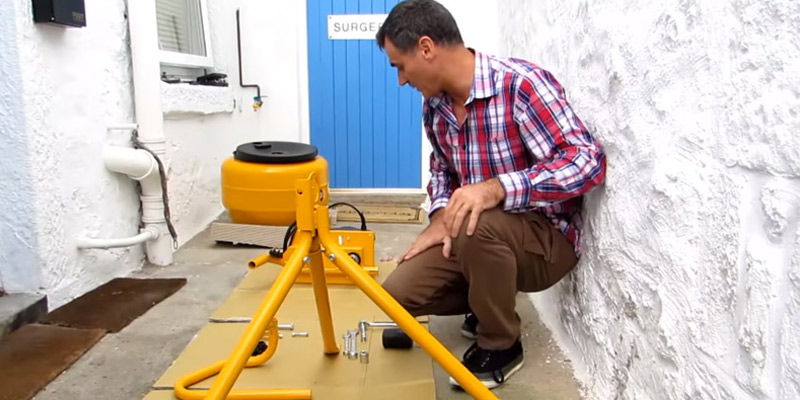
Efficiency through High Quality Materials
Using the gravity method, the Belle MB01 utilises a 450-W motor to work efficiently and relatively quietly to make the necessary mixtures. You can create mortar, cement, and many other building mixes by using this one machine. The drum turns at 28 rpm and is extra thick for added sturdiness and has specialised “quick mix” paddles that will make quick work of even the biggest load and distribute the components evenly, eliminating the dangerous air bubbles that could undermine the structure.
As this model is not equipped with wheels for extra portability, you might prefer using it for projects of smaller scale where you won’t need to move it around too much. The machine comes with a barrow-height swivel stand that adds manoeuvrability, though, so don’t worry about turning the drum or adjusting it.
Besides, the Belle MB01 is actually comparatively lightweight at just 35 kg, not the lowest weight available but definitely up there. So, even if you do end up having to move the mixer, you won’t need several people to lug the machine around, it can be picked up easily by just one person.
Overall, this is a solid choice for smaller amateur projects thanks to its efficient work, accessible design, and reasonable specs. Great for your first serious DIY project!
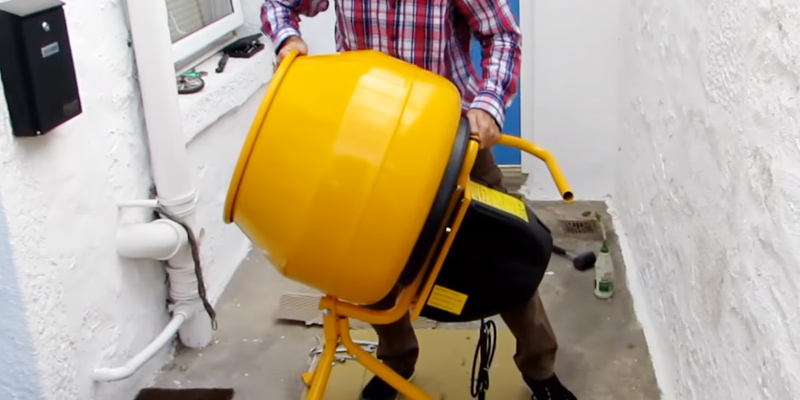
Additional Info
| Last updated price | $0.00 |
| Stock | May be out of stock |
| ASIN | B007VYFZ1M |
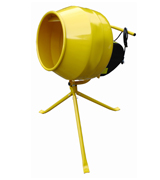
SwitZer CM120L
High-Capacity and Very Convenient
Any home renovation enthusiast or professional builder can tell you that cement mixing is not an easy task and doing it by hand is very demanding, hard to master, and overall impractical. That is why it’s prudent to get a good, powerful 240V electric cement mixer like the SwitZer CM120L, a great product that will ease your work substantially.
This model will do perfectly for any small- or medium-size building projects that you might want to do to improve your house or as part of your job. Either way, the high-capacity drum can hold up to 120 litres of material and create up to 90 litres of mixture per cycle. You won’t have to spend precious time on constantly pouring new ingredients in and taking out the resulting mix.
For maximum convenience, the drum opening measures 34 cm, wide enough to comfortably put the materials in and get the mixture out. The tipping wheel lets you carefully turn the drum over and pour out the contents into the appropriate container and the two wide wheels make this machine easy to transport. It’s designed with convenience and speedy operations in mind. Using the popular gravity mixing technology, you can make big volumes in no time flat without risking your health or wasting your time on handiwork.
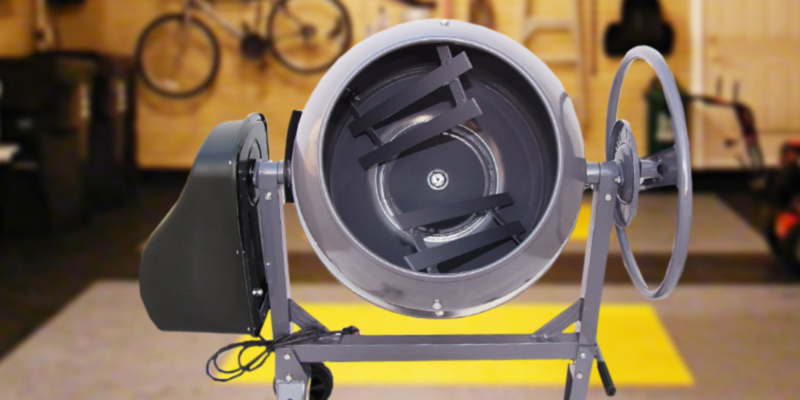
A Beast of a Motor
The SwitZer CM120L is quite compact and can easily fit into a small room where you’re going to be working, no need to worry about wheeling the machine back and forth or having to carry hefty containers with the cement mixture from outside. While this model is not tough to move around thanks to the two wheels and a convenient round handle, it still weighs 44 kg, not exactly something you’ll want to carry around the worksite.
Powered by a 550 W motor, the SwitZer mixer does 28-30 rpm. You will complete your tasks quickly and efficiently, though it’s important to note that some ear protection could be good with this particular product. The noise insulation is the only part of the machine that isn’t stellar and it does tend to get pretty loud during operations. And the motor is reportedly actually a bit powerful and handles bigger loads better than small ones overall (below 10-20 litres).
As everything about this model is designed for convenience, it comes with a standardised 3 pin plug, made for the UK sockets.
Overall, the SwitZer CM180L is a powerful 240V mixer that will help you make as much cement as you may need in record time. It’s a great choice for both amateurs and professional construction workers.
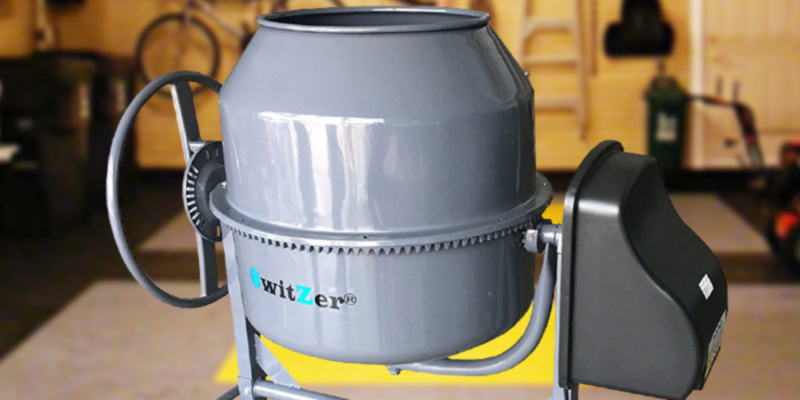
| Last updated price | $0.00 |
| Stock | May be out of stock |
| ASIN | B01IPGSVIS |

Megamix CM70
Lots of Power in a Small Package
Construction work is not an easy task but you can make it much simpler with a high-quality mini cement mixer that will take on all of the hard parts of the job. If you’re in the market for a solid helper machine, check out the Megamix CM70, a small and easily portable model that will speed up any building project significantly.
Despite its small dimensions, this is a rather powerful machine, all thanks to the 250 W motor capable of 30 rpm. This is almost on a par with the high-end large models that would, however, take up twice as much space and fill the worksite with unbearable noise. The compact and quiet Megamix CM70, while not a juggernaut of power, certainly has its advantages and will be a wonderful choice for small-scale projects. Filling in potholes, laying the foundation for a small gazebo, or making some mortar to patch up your house? Why not do it quickly, quietly, and without a huge machine taking up the whole yard.
This is one of the few products of this kind that has a good warranty backing it up with a full coverage for one year. This means that you can get your money back in case any unforeseen incidents happen or some accident damages the equipment.

Playing with the Big Boys
With a maximum capacity of 70 litres, the Megamix CM70 can make up to around 45 litres of mixture per cycle. Just use the modestly-sized 24-cm drum opening to put in the components, turn on the machine, and wait until your cement or mortar is ready. The drum is even outfitted with specially designed paddles that are placed specifically to optimise work on both large volumes and small ones of up to 10 litres.
The lightweight 25 kg model is easy to carry around but, if you want to save your strength, a handle and wheels are available to make transportation simple and speedy. The Megamix CM70 is highly portable and you won’t need any specialised equipment or a whole crew to move it from one part of the worksite to the other.
Do note that the bright yellow paint on the casing is applied rather poorly and won’t hold for too long. You might end up with some chips here and there and the colour of the metal will look through. But you’re not buying this machine for its looks, it’s the power that matters.
Overall, the Megamix CM70 is a great pick for those that want a small but high-capacity machine to mix concrete efficiently and quickly, eliminating the need for a lot of menial work. And, if you plan on doing some serious DIY work, browse some tool bags that will help you keep track of all of your instruments.
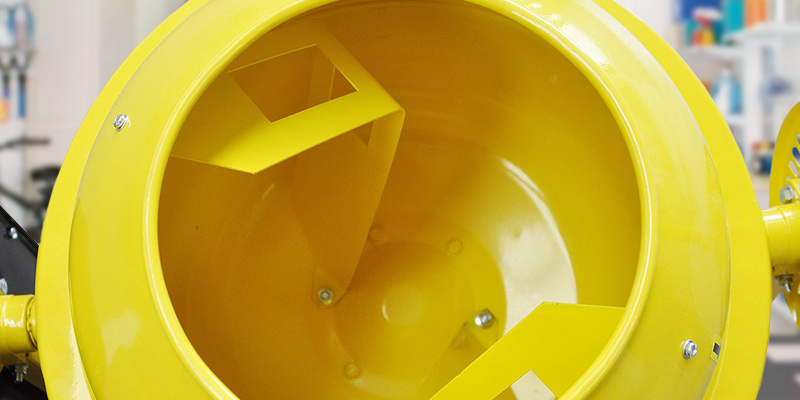
| Last updated price | $0.00 |
| Stock | May be out of stock |
| ASIN | B01IRHS8WE |
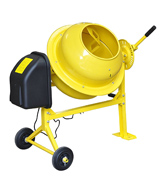
Dirty Pro Tools Professional Cement Mixer 80l
Mini-Mixer Designed to Be Convenient
If you have a small worksite but still need a volumetric concrete mixer that will get the job done fast, take a look at the Dirty Pro Tools Professional Cement Mixer 80l. This model combines portability and high capacity in one well-made machine that will help you finish any building project on time.
Despite being a very compact model, this mixer has a maximum drum capacity of 80 litres and can mix up to 55 litres per cycle, which is about equal to using a single 50 kg bag of cement. Just load the material in, add water, turn on the engine, and watch as the Dirty Pro machine does most of the work for you.
The drum opening is reasonably wide at 33 cm, so you can just tip the whole bag of cement over and let it pour out into the drum. If you want to move the machine closer to your stack of materials, just grab onto the comfortable round handle and drag it over. This model is comparatively lightweight at 45 kg and has two wheels for easy transportation. Do note that the tyres get worn out rather quickly and while you’ll still be able to move the machine, you might want to look for some replacement tyres right away. Still, the machine is indeed quite portable and you won’t need a whole crew to move it around the worksite.

Extremely Sturdy and Operates Quietly
For added convenience, the drum on the Dirty Pro Tools Professional Cement Mixer can be tilted using the tipping wheel for extra convenience. People of a shorter stature won’t have to stand on tiptoes to put the materials in and taller users won’t have to bend down to an uncomfortable position. The gears of this mechanism are cast iron for extra longevity, you won’t end up with a rusty machine just a year in, the Dirty Pro mixer will serve you for years and years.
Powered by a 240V/350 W engine with 33 rpm, this model will make the mixture quite quickly and the high-quality paddles guarantee that the concrete will have no air bubbles that can undermine the integrity of your structure. Plus, the motor block has very thick insulation so even at maximum load the mixer will operate very quietly. You could be standing a couple of metres away and not even hear it. That makes this model great for smaller worksites and even cramped spaces as you won’t be bothered by any noise while working on the other parts of construction. As the Dirty Pro mixer is just 1.2 by 0.72 by 1.18 metres, you can easily wheel it right into the room where you’re going to be building.
Overall, it’s a wonderful choice for small-scale building thanks to its silent operation, wheels for high portability, and pretty high-capacity drum. This is a good mixer for those working on some DIY projects at home.
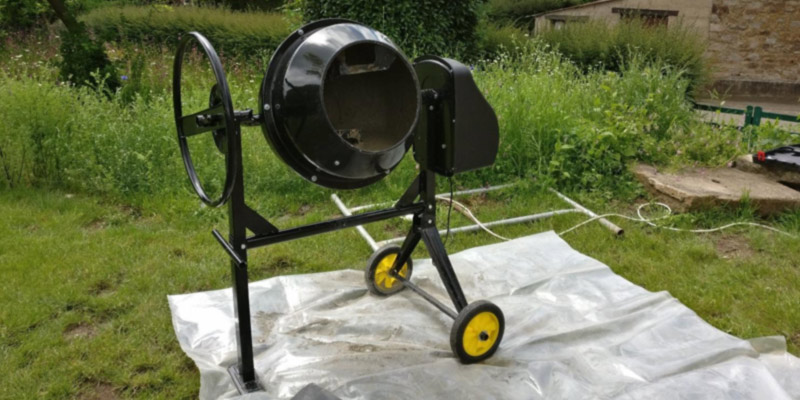
| Last updated price | $0.00 |
| Stock | May be out of stock |
| ASIN | B00Z1PWIKE |

Beauty4Less CMIXER63
Protected from Power Surges
If you’re operating on a worksite with unstable power lines, you’ve probably already grown used to looking for equipment that has protection against surges that could fry the basic models, halting work for a long period. To protect one of the main construction processes and make sure that you keep going under any circumstances, check out the Beauty4Less CMIXER63, made with safety measures that save your equipment in unforeseen circumstances.
This orange electric concrete mixer is resistant to small power surges, which can occur quite frequently at a construction site. When building something, you often have to use many tools at once, so the grid may get overloaded and any instrument with no protective measures can get fried. Even if the voltage drops 10% below the required norm, the machine won’t stop running and your cement will still get mixed.
It’s also great for transportation with a handle that you can grip to move the machine and two wheels attached for extra portability. Plus, this is one of the more lightweight models available in the market at a measly 25 kg. This makes it absolutely great for projects where you have to use the mixture in many places and need to move the mixer around a lot.
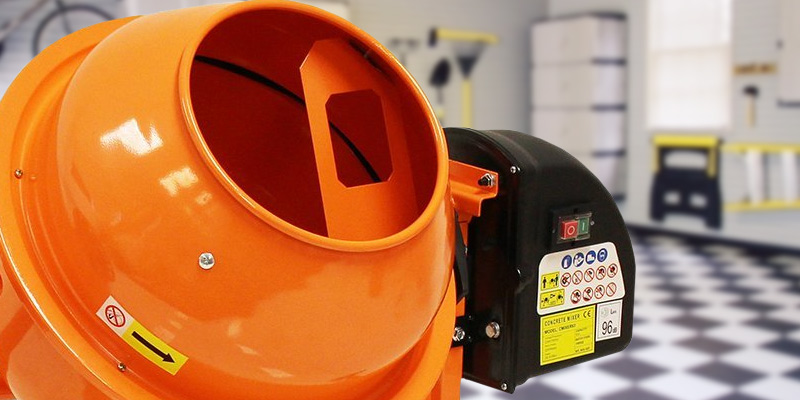
Lightweight yet Still Powerful
The bright orange Beauty4Less CMIXER63 is not only stylish and easy to transport, it’s also relatively powerful for a model of its size. Despite being incredibly compact, this model has a 220-W motor that guarantees 30 rpm, which is pretty impressive for such a small machine. This is, of course, not a huge industrial-scale machine but it’s pretty clear that this product is directed towards portability, fast operation, and quiet work. It’s really not far behind the bigger counterparts that would cost you three times the prices of this mini-mixer.
The drum on this model supports up to 63 litres and can produce 40 litres of concrete per cycle. The opening is 24 cm, just wide enough to tip a standard bag of cement into the drum. You can, of course, use the tipping wheel to tilt the drum into a position that’s convenient for you. A handle is also available if you don’t care about precision and just want to pour out the contents.
Overall, the Beauty4Less CMIXER63 is a very affordable mixer that can be moved around the worksite freely thanks to its low weight and two wheels. It can handle reasonably big loads and makes concrete no worse than the bigger competitors. The most important feature, though, is the protection from power surges that helps to keep your equipment intact even in case of an accident.
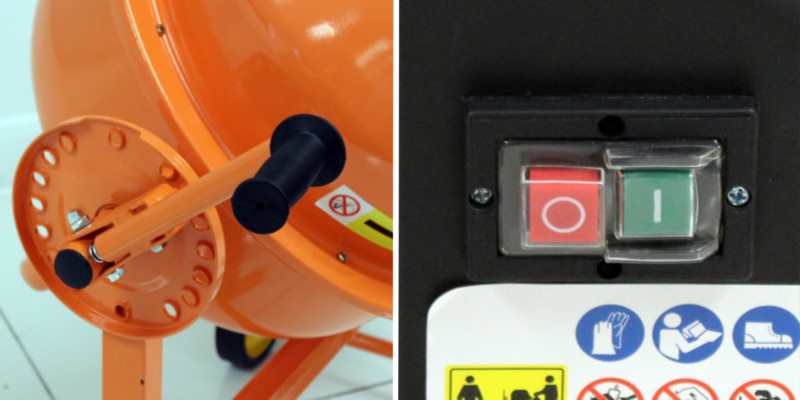
| Last updated price | $0.00 |
| Stock | May be out of stock |
| ASIN | B01GS8HAUA |
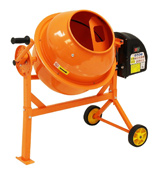
What Is a Concrete Mixer?
Concrete mixers are vital for construction or repair works. A concrete mixer is a unit for preparing of mortar through mixing its components. A mixer considerably facilitates the process of making concrete and, as a result, significantly boosts productivity. Yet, even experienced builders might not know everything about concrete mixers. How to choose a proper concrete mixer that will last long and won't hit your pocket? Our review will tell you all about that.
If you are engrossed in home construction or repairs, you might also be interested in hammer drills and paint sprayers.
What Features to Compare
Capacity
First of all, determine the scope of work that must be done before buying a concrete mixer. Then pay attention to a mixer’s capacity to understand whether it meets your needs or not. All concrete mixers can be divided into following categories:
- Concrete mixers up to 3.6 cu.ft. Suitable for construction of medium-sized objects (garages, summerhouses, etc.). Such mixers will be great for home use. Perfect for one worker. The weight of such mixer is about 45 lbs.
- Concrete mixers up to 5.3 cu.ft. Designed for single-storey buildings. The models with a capacity of 4.6 cu.ft are the most widespread. A mixer of this category weighs about 89 lbs.
- Concrete mixers up to 10.6 cu.ft. They are developed for large-scale construction projects, for example, three-storey buildings. The weight of such mixer is about 110 lbs.
- Concrete mixers over 10.6 cu.ft. These mixers are appropriate for construction of multi-storey buildings. As a rule, their weight is 353 lbs and more.
Take into account that the higher the capacity is, the heavier the mixer is. Also, remember that the drum needs some free space to blend the content. Thus, the amount of slurry to be made should be 10-15% less than the drum capacity.
Performance
Performance is another parameter important for choosing a concrete mixer. Performance depends on several factors such as the motor power, the mortar output, and mixing method. According to a mixing method, concrete mixers are divided into 2 types:
- Forced concrete mixers
The mixing drums of such mixers are immovable, so mixing is performed by rotating blades. If you are going to make a liquid mixture without solid particles, a forced concrete mixer is the very thing you need. Also, consider that forced concrete mixers are high-capacity and are designed for large objects.
- Gravity concrete mixers
Those who need a dense mortar with multiple solid particles for construction or repair activities should pick a gravity concrete mixer. Such mixer is equipped with a tilting drum with the blades inside. The construction aggregates must be loaded manually to gravity mixers up to 10.6 cu.ft, while the machines of higher capacity feature automatic loading.
The concrete mixer performance directly depends on the power of a motor. A powerful motor allows continuous mixing all day long. In addition, it is not susceptible to voltage drops that sometimes occur on construction sites. Plus! The mixers with high-power motors enable full drum loading.
Usability
Lastly, once you define the key features of a concrete mixer, pay attention to its usability. Here you should consider a gear that is vital for reliability. Concrete mixers may be equipped with either reduction or ring gears.
- A ring gear features a toothed ring on the mixing drum which is driven by a pinion shaft. Ring gears are not enclosed and might get broken because of construction debris. A ring gear material deserves a closer attention; it may be made of steel, cast iron or plastic.
- A reduction gear is more reliable as its mechanism is protected from debris, sand, etc. But, if the motor or pinion gets broken, the repair would be pretty costly.
Usability also depends on the design features, such as tilting ability, transportability, size and weight.
Did you know?
Even back in the far past, the ancestors of what we, in the modern day, call ‘cement’ ruled the construction process and were invaluable to many of the more advanced civilisations. The first mixes that resembled concrete were discovered such a long time ago that they had many centuries to change, evolve, and turn into the modern versions that we use today to create buildings, roads, and a variety of other objects.
Back in the Old Days
The ancient Egyptians, Greeks, and Romans all used their own versions of what they called ‘cement’, wildly different from what we have now. Egyptians’ mix of choice was calcined gypsum, while the Greeks and the Romans all used lime. The latter was made by heating up limestone and pouring in some sand or stones. The addition of sand resulted in mortar while stones gave you concrete.
As is customary, the Romans started to win the ‘technology’ race and created a cement mix that could set under water. That made harbour construction significantly easier and allowed them to create great ports. This mix, later dubbed as a “pozzolanic” cement, was made with lime and crushed volcanic ash. (The name comes from a small village at the foot of Vesuvius, the great and fearsome volcano.)
Meanwhile, our British ancestors, understandably having little access to volcanic ash, used crushed brick instead, making do with what they had.
Further Advancement from the Romans
You might already know that, when the great Roman Empire fell, building and technology were set back substantially all over Europe, which largely looked to the Romans for progress. But let’s see just how advanced they were.
In the first century BCE, a Roman architect and engineer wrote an extensive account of Roman architecture that detailed several relevant construction techniques. First off, he talked about concrete floors, calling them “the most important of the polished finishings” and reporting that they were made with “pounded tile mixed with lime in the proportions of three parts to one”. Writing on the subject of pozzolana he said: “This substance, when mixed with lime and rubble, not only lends strength to buildings of other kinds, but even when piers are constructed of it in the sea, they set hard under water.” And these are just a couple of relevant passages from a huge and expansive text on the history of construction from many centuries ago.
When Rome fell, Europe turned mainly to using lime carbonation for cement, which was a slow and nonoptimal process. The pozzolana was, however, discovered again but that reinvention took a while, occurring only in the late Middle Ages. But even then, some of the more renowned engineers still failed to reproduce the amazing results achieved by the Roman architects a thousand years ago.
Progress Marches On
Of course, the development of new mixes didn’t stop there and cement changed and grew over several centuries before it got to its current state. And even now, while we sit comfortably in our concrete buildings, work and live inside them, scientists and engineers are coming up with new ways to strengthen, diversify, and perfect the wonderful material that came to be several thousand years ago.
FAQ:
Q: How do I know if I’ve mixed concrete properly and check whether it can be used for work?
A: An easy yet reliable way to determine the quality of your concrete is to perform a so-called “slump test”. To do so, get an inverted, bottomless cone (a paper cup with its bottom cut out would do fine) and fill it with the mixture. Pack it thoroughly several times while you fill and then remove the cone carefully by lifting it straight up. Now, put it beside the concrete pile. If the cement is as tall as the cup or less than half of its height - it’s no good and something has gone wrong in the mixing process. If, however, the pile is anywhere from 50% to 75% of the cone’s height - you’re good to go and the mix is great.
Q: I’ve heard of air bubbles forming in the moulds. Are they detrimental to the mixture or should I not worry about them?
A: These bubbles can and will become weak points in your concrete and won’t withstand the strength tests so it’s very important to get rid of them. There are a couple of ways to do this, namely: pack the concrete tight, make sure no empty spaces are left; tap the sides of the mould while you’re filling it for easier and smoother distribution of the mixture; “rod” the mixture in the mould using a thin tool, a spatula will do just fine.
Q: Any tips for tools upkeep when working with concrete?
A: The first and most important rule is a simple one. Wash your instruments thoroughly and immediately. If you’re not going to use a particular tool in the next hour - clean the cement off of it or you risk ending up with a spatula stuck in a block of concrete or a shovel that you won’t be able to lift. Cleaning may be a hassle but it’s essential to preserving your instruments in good shape and not having to waste money on repairs.
Q: What about safety? It’s my first time working with concrete, do I need any protective equipment or is it okay to work with the mixture without any extra precautions?
A: It is absolutely necessary to wear some safety equipment unless you want a long trip to the hospital. Cement is a caustic, abrasive, and quick to dry so it can be dangerous in a variety of way including skin contact, eye contact, or inhalation.If wet concrete comes in contact with your skin and gets washed off quickly, it will only cause a bit of irritation. Longer exposure, though, will burn your skin and cause lasting damage. Burns of every degree are entirely possible, especially if some of the mixture gets “trapped” against your skin, by getting into your gloves or boots.
Moreover, some people may be allergic to hexavalent chromium, a component of cement. In fact, if you work with the mixture long enough and often enough, the allergy might just develop on its own. This allergen can not only cause skin reaction but trigger an effect when inhaled, causing respiratory issues.
Lastly, concrete or dust from it can cause burns or blindness when it comes in contact with your eyes, so protection is absolutely vital.
All in all, it’s best to wear protective clothing, goggles, a respiratory mask, and gloves to prevent any direct contact with the mixture. Consider getting all of these along with your purchase of a mixer because working without them would just be irresponsible.
Sources:
1. Concrete Mixers Information, IEEE GlobalSpec.
2. Your Guide to Buying the Right Cement Mixer, eBay. August 27, 2013.
3. How to Use a Cement Mixer, wikiHow.
4. What Happens To A Bridge When One Side Uses Mediterranean Sea Level And Another The North Sea? Science 2.0. October 2, 2013.
5. Reduction Drive, Wikipedia. August 8, 2016.
6. World's Littlest Skyscraper, Wikipedia. August 17, 2016.



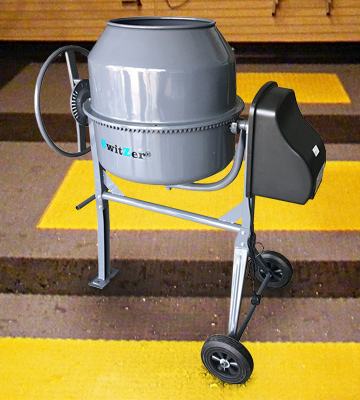
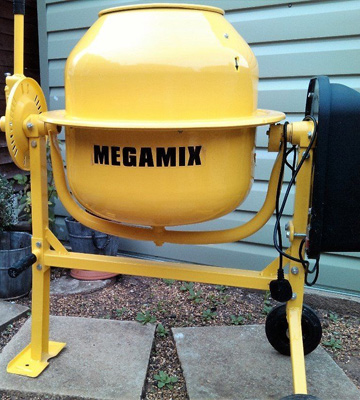
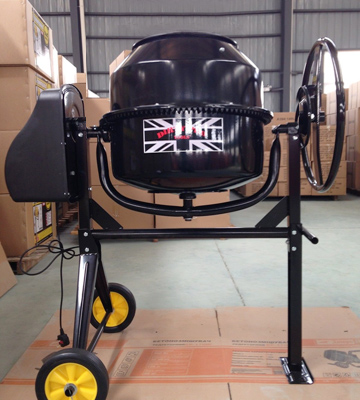
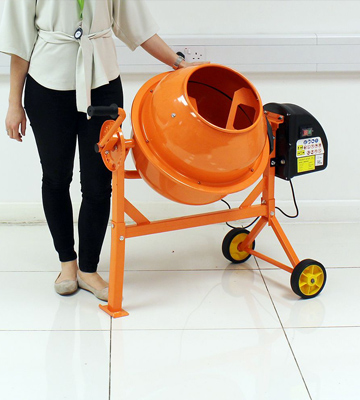

Your comment was successfully sent
Error! Please try again later